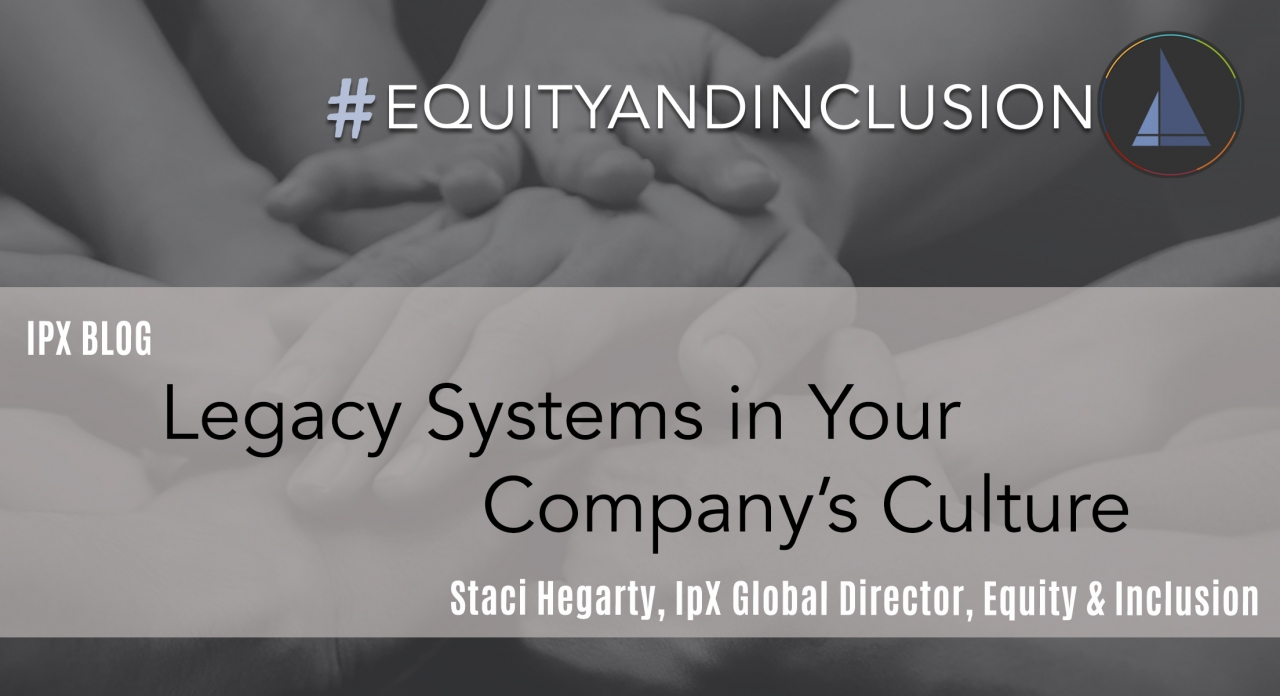Legacy Systems in Your Company's Culture
10/09/2020
Staci Hegarty, IpX Global Director of Equity & Inclusion
Most of us know what a legacy system is in software and computer systems. It's the system that was chosen years ago, for reasons that may no longer be clear. Maybe the system works okay for now, but the fixes are expensive and time-consuming when they come up. Additional things have been added to your business, and the upgrades either don't interface well with the legacy system or perhaps not at all, so there is another step added to the process. Maybe the legacy system still works fine for engineering, but it can't support the rest of the enterprise.

In almost every meeting, the issue of a legacy system arises. Most people agree that it is a problem, but replacing a legacy system is not easy. First you have to establish requirements and decide on a good replacement, then you have to find the money. How will we make sure that critical information isn't lost in the transition? Can current equipment even run the new system? How are we going to get everyone trained? How much time will be lost making the change? It's complicated and messy and no one wants to do it even though everyone agrees it needs to be done. Like ignoring the small crack in the foundation of your house, it's only going to get more difficult and more expensive to repair.
What does this have to do with inclusion and equity at work? Everything.
I work for a company that is best known for CM2, a configuration and change process management platform. Conventional configuration management focuses on manufacturing and engineering of a physical product - the processes and tools. Over the years CM2 has expanded to include the entire enterprise, recognizing that every organization has its own ecosystem - the processes, tools, and people. When we work with clients, one of the key factors in preparing to make a change is assessing the organizational readiness for change. The processes and tools won't make much difference if the people aren't ready. Before long, our organizational change management services were a swelling part of our model. We looked closer and it became clear that how people feel at work has a direct effect on how people perform at work. Not how they feel about their paychecks or their tasks, but how they feel about being a part of the workplace community. Do they feel that they belong and are accepted for who they are?
Legacy systems are not just software.
Legacy systems show up in our policies, job descriptions, hiring practices, incentive plans, and company celebrations. They are in our marketing and advertising. They are reflected in the Board of Directors. That doesn't mean those systems are necessarily bad or intentionally biased, but we need to make sure they are evolving to meet the needs of our employees, our communities, and our customers. Just like technology, culture evolves. Chances are your workforce does not look like it did 30 years ago. Are you expecting to keep the same systems and force people to comply? They may try to conform for a while, but sooner or later they will find a job that embraces them instead of demanding that they leave who they are at the front door.
Conversations about diversity, equity, and inclusion (DEI) can make people very uncomfortable. The terms seem ambiguous, what does diversity even mean? For some people, the language of DEI is not only unfamiliar, it sounds like complaining or even blaming. It may even seem like some sort of trap, just waiting for an unsuspecting executive to say the wrong thing. Comprehensive DEI platforms are not a big game of "Gotcha!" They are designed to help companies get out of their own way. When we are able to understand where people are coming from, we can better serve them. When we look at our legacy systems in culture, we can make upgrades that make things easier for everyone.
Building a more equitable and inclusive workplace is just like replacing a legacy software system. It can be complex and even messy at times. It's easy for organizations and their leadership to decide it isn't worth the investment right now, that there are other things that are more important. For many, the approach is that if it seems to work okay for now, they will plan to budget for it in the next year or two. Meanwhile, the people who use it every day are wondering when something is going to be done because they know they can't keep using the outdated system much longer. Organizations are more than products and tools; they are the people who work there, the customers who buy their products or services, and the communities of which they are a part. Creating a culture of belonging is not only possible, but necessary for innovation and growth.
Read about the
IpX RISE DEI platform – Respect through Inclusion, Service, & Equity. RISE is a training and service model to create an environment where all people are encouraged to draw upon their unique experiences, perspectives, and backgrounds to ensure sustainable long-term success of the organization.
